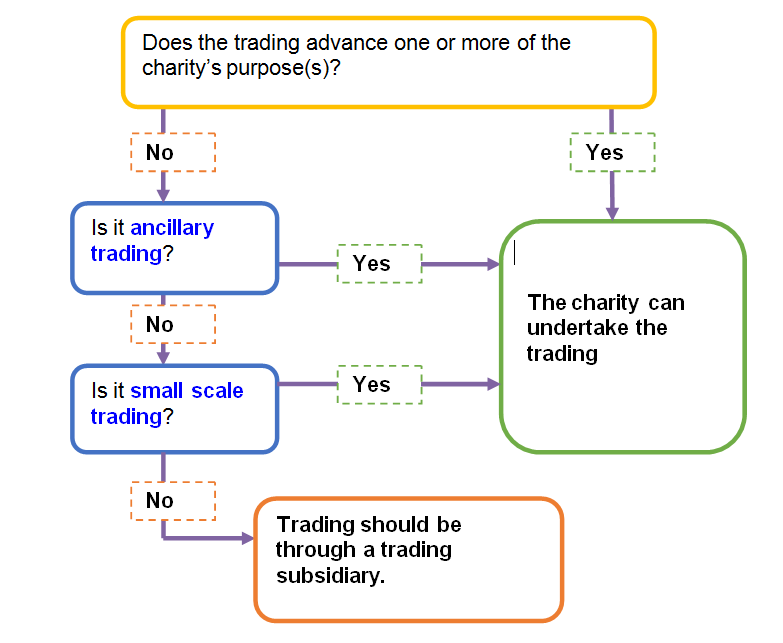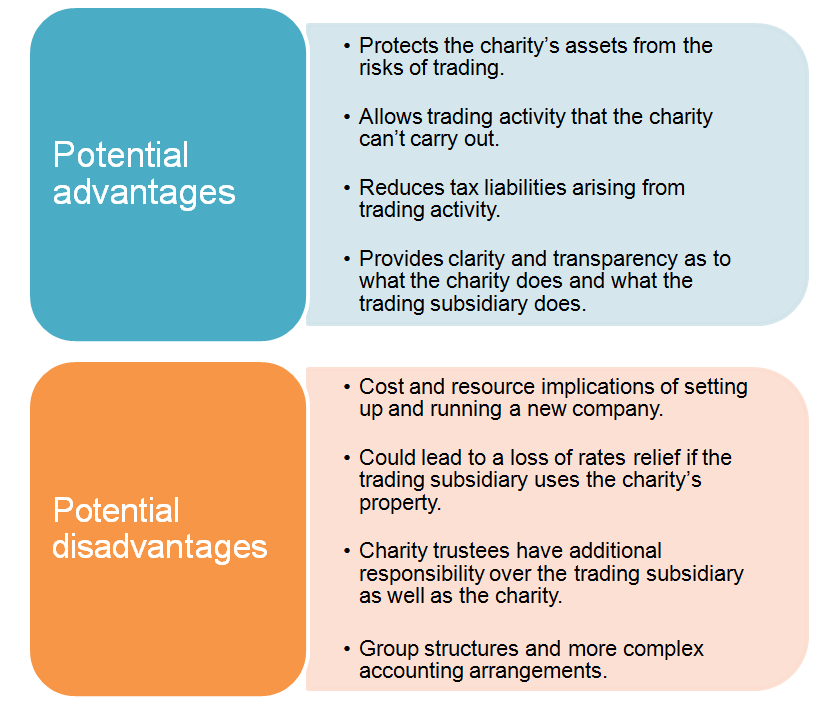2. Trading Subsidiaries
2.1 What is a trading subsidiary?
A ‘trading subsidiary’ is a separate legal entity (often a company with share capital) owned and controlled by one or more charities.
The main reason a charity sets up a trading subsidiary is to undertake non-primary purpose trading as a way to generate income for the charity.
If a charity engages in significant levels of non-primary purpose trading it will need to pay tax on the profits. If this is carried on by a subsidiary, the subsidiary can donate the profits back to the charity under the gift aid scheme (time limits apply), ensuring that no tax is paid by the trading subsidiary. This allows all the profits to be used for charitable purposes.
Charities may also undertake trading through a subsidiary to protect the charity from the risks of trading, such as risks to the charity’s assets, or the risk of incurring trading losses.
A trading subsidiary is not a charity. The role of the subsidiary is usually to generate income to support the charity – not to provide services which should be undertaken by the charity itself. Therefore the activities carried out by the trading subsidiary do not count towards the public benefit provided by the charity’s own activities.
Charity trustees must be very clear about which activities should be undertaken by the charity and which should be undertaken by the subsidiary. It is important to get the structure of your group right, to make sure that you continue to meet the charity test, and that you are trading in the most efficient manner. If all the activity is undertaken by the subsidiary company then there will be concerns over the level of public benefit the charity itself is providing.
2.2 When should a charity set up a trading subsidiary?
When any of these apply you should consider undertaking the trading through a non-charitable trading subsidiary:
- The trading activity that the charity wants to undertake does not directly advance its charitable purpose(s) and is not ancillary or small scale.
- The charity does not have the power to trade directly.
- There is significant risk to the charity from the activity. For example, where an unincorporated charity needs to enter into contracts, such as property, service or employment contracts.
- A tax liability is likely to be incurred.

2.3 What do you need to think about?
The first thing to think about is whether there is anything in your governing document that prevents the charity setting up a trading subsidiary, such as a restriction on investments. You might need to take advice to decide if that is the case and make changes to your charity if necessary.
As charity trustees you need to consider what is in the best interests of the charity, including the advantages and disadvantages of setting up a trading subsidiary. Where trading is substantial and there is a significant risk to the charity’s assets then a trading subsidiary will be essential in order to make sure the assets are protected.
Where the use of a trading subsidiary is not essential you will need to consider the advantages and disadvantages. These will be individual to your charity, but there are general considerations that apply to many charities:

2.4 Setting up a trading subsidiary
As with any company the trading subsidiary will need directors, start up funding and resources. The trading subsidiary must be a completely separate organisation from the charity. Generally a trading subsidiary will:
- Be a registered company (often limited by shares) or Community Interest Company (CIC)
- Have general trading objects
- Not be a charity
- Have the charity as the sole shareholder or member
- Be capable of generating a profit for the charity.
2.5 Managing the relationship between the charity and trading subsidiary
As charity trustees you need to act in the charity’s interest and with care and diligence. This means you should monitor how the trading subsidiary is performing and how well it is meeting the goal of raising funds for your charity. The level of oversight charity trustees have in relation to the trading subsidiary will vary but as the shareholder or member your charity, and therefore you as its charity trustees, are often responsible for:
- Appointing trading subsidiary directors
- Deciding on the role of the directors
- Removing directors
- Deciding, along with the directors of the trading subsidiary, whether or not it should continue.
There needs to be a clear line of responsibility to the charity for the trading subsidiary operations. The charity trustees need to monitor performance and be aware of what is going on in the trading subsidiary.
The charity and the trading subsidiary could have a written agreement in place that sets out the relationship between the two organisations, the lines of accountability and the oversight the charity must have.
Key points to consider are:
The trading subsidiary and the charity are separate organisations and this should be clear from the names so that the two are not confused. The trading subsidiary can have a similar name to the charity, but the difference between the two should be clear.
|
For example: A charity called ‘Jelly Beans Children’s Charity’ may have a trading subsidiary called ‘Jelly Beans Trading Ltd’. |
There are rules under company law about names which you should be aware of before choosing a trading subsidiary name.
Many charities and their trading subsidiaries will share resources such as premises, equipment and staff. Where resources are shared there must be formal agreements in place and the trading subsidiary must pay a fair rate for the use of the charity’s resources.
In particular, where the trading subsidiary uses the charity’s buildings there should be a formal lease in place and rent paid to the charity at a rate which is comparable to that which could be achieved on the open market. There should also be a written agreement regarding any other services provided by the charity to the subsidiary (or the other way round).
There needs to be a clear line of responsibility between the charity and the trading subsidiary. Often some of the charity trustees are also directors of the trading subsidiary. This relationship can cause conflicts of interests for charity trustees and others, especially where there are transactions between the charity and the trading subsidiary.
Charity trustee duties require you to act in the interests of the charity. Where the interests of the charity and those of the trading subsidiary conflict you must put the interests of the charity first.
Because of this duty you should think about the proportion of trading subsidiary directors that are also charity trustees. It is important for the charity trustees to have clear oversight of the trading subsidiary but also for the subsidiary to have directors that are independent of the charity.
As a charity trustee, you must put the interests of the charity before your own interests or those of any other person or organisation including those responsible for your appointment. Where you cannot do that, there may be a conflict of interest.
There are specific rules about paying charity trustees and connected persons. These rules do not extend to payments made by the trading subsidiary; however any remuneration paid by a trading subsidiary company will ultimately reduce the level of profits to be received by the parent charity. The charity trustees should have an understanding of the levels of remuneration paid by the trading subsidiary and consider whether these are appropriate.
As a charity trustee you should be aware that the directors of the trading subsidiary will have legal duties under company law, many of which are similar to charity trustee duties.
The aim of a trading subsidiary is to generate income for the charity. Whilst a charity may support the trading subsidiary initially we would not expect funding to continue long term. If it becomes the case that the trading subsidiary cannot support itself, and generate income for the charity, the charity trustees should consider whether they wish to continue with the investment.
Funding for a trading subsidiary should be judged just as any other charity investment and the investment should not be undertaken if it is not expected to produce a profit in the long term. Finance may be provided by means of share capital or loan capital.
Where finance is provided to the trading subsidiary in the form of a loan we would expect there to be formal loan arrangements in place. The loan should be provided on a commercial basis with appropriate repayment terms and a market level of interest charged.As a charity trustee you have a duty to put the interests of the charity first. If the trading subsidiary is operating at a loss for a sustained period of time then you need to decide if the trading subsidiary should close.
The reason for setting up a trading subsidiary is to generate funds for the charity and to protect the charity’s assets. Where the charity is propping up the trading subsidiary and not getting any of the benefits it is difficult to see how this is in the interests of the charity and how the charity trustees are fulfilling their legal duties.
Charity trustees must be clear that if they use the charity’s assets to support a failing trading subsidiary then they are putting those assets at risk and failing in their duties.
Charity trustees must minimise any losses to the charity, regardless of any sense of moral obligation they may feel towards the trading subsidiary, its directors and employees.Funds can be passed from the trading subsidiary to the charity by a share dividend, interest on, and repayments of loan capital, through rental agreements or as Gift Aid donations.
Where a charity has provided a loan to a trading subsidiary it will be appropriate for repayment and interest to be received under the terms of the loan agreement. Outwith this the most tax efficient way for a charity to receive funds will be through a Gift Aid donation.
Gift Aid payments reduce the trading subsidiary’s taxable profit by the amount of the payment, and as such a Gift Aid payment can eliminate any corporation tax liability in the trading subsidiary.